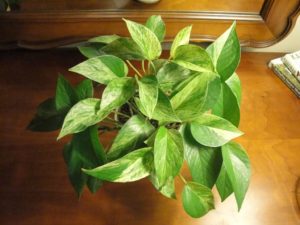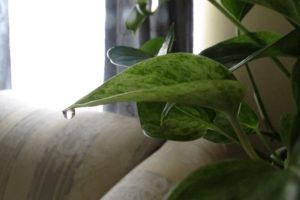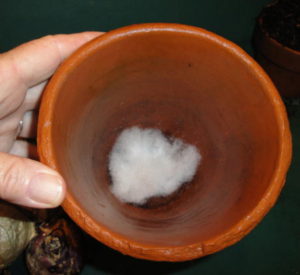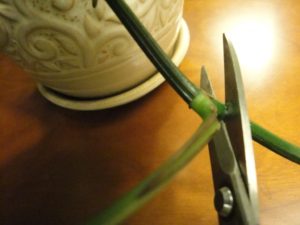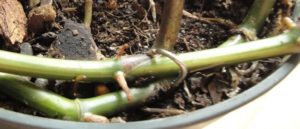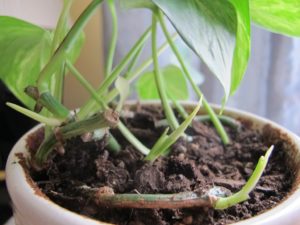Page 2
Watering Pothos
“How can I tell when pothos needs water?”
Your best guide is your finger, so feel 1″ or 2″ into the soil. If you detect any moisture at all, don’t water yet. Even though the soil surface feels dry, there could still be adequate water in the lower portion of the pot. Let the soil go barely damp, but not entirely dry, before watering.
Moisture meters I’ve used varied widely in the results. One tested an absolutely bone dry plant, and yet the meter displayed “moist”. Expensive meters might be more accurate, but trust how the soil feels to you.
Another way to test for moisture is to plunge a narrow, unfinished wooden dowel or skewer all the way into the pot. Leave it there for 15 minutes or so, then pull it out. Wipe off the soil. Darkened wood indicates moisture in the soil, so the plant can go a while longer without water.
Let It Wilt?
Some gardeners water their plants when the foliage wilts. Letting plants regularly wilt stresses them. They’ll have little net gain in foliage. Lower leaves might turn yellow and/or curl under, and then die. If pothos stays dry too much longer, roots will die off and some or all of the stems might not recover when water returns.
If you water when the leaves begin to wilt, however, the plant probably will be okay. But try to water just before the plant begins to wilt to avoid stressing the plant.
Feel the Weight
As you live with your plants, pick up the pots now and then and feel their weight. Soon, you’ll be able to judge a dry pot from a moist pot based on this single criterion.
A wilted plant in a heavy pot doesn’t indicate dry soil, but that it has been overwatered and that the roots are rotting. When roots aren’t functioning normally, they can’t absorb water, causing the foliage to wilt. Constantly wet soil invites fungal and bacterial pathogens to infect the plant, killing it. Without adequate oxygen levels in the soil, roots can’t respire and grow new cells.
Pothos likes soil that stays slightly moist. If there’s any dampness in the soil, and the skies are going to be overcast for a few days, delay watering for a day or two unless it’s absolutely necessary.

When Water Can’t Drain
Potted plants placed inside baskets or decorative pots without drainage holes need cautious management. Take, for example, that ‘Marble Queen’ pothos I mentioned earlier. Instead of plopping it into an unlined basket, I added 2 layers of 4 mil plastic film (from the hardware store) in the bottom and up the sides to prevent water leaking onto Grandma’s old end table.
Don’t let water collect in the bottom of a decorative ceramic pot or a lined basket. That will breed pathogens, which infect the roots. It also interrupts beneficial air flow around the bottom layer of the root ball. Within 15 minutes of watering the plant, draw off or empty water that wasn’t absorbed.
This principle applies to all plants grown “double-potted”. Yes, there are a few exceptions, such as plants that normally grow with their roots in water. Overwintering tropical water lilies and Cyperus come to mind, but not many others.
Water Temperature
In winter, I lower the thermostat to a temperature that does not overly please pothos. When my tropical plants need water, I use lukewarm water, about 85° to 90° F. Whether they actually feel better with that, I’ll never know. But I do. Actually, research indicates that cold water can shock plants, but many dispute that finding.
Giving houseplants stronger light increases their tolerance for a few other less-than-perfect conditions, such as lower temperatures and shorter days.
Guttation
Aroids commonly drip water from the leaf margins or from the leaf tips. This happens when the soil is moist or wet and ceases when the soil has dried sufficiently. When the roots absorb more water than the plant needs, it releases some of the excess pressure through special pores called hydathodes.
Because guttation usually happens at night, we often see a few drops of water on the table the next morning. Keep this in mind if you want to place the pothos on that nice cherry dresser.
Potting Up
Why the Soil Surface Drops Lower
I never repotted that ‘Marble Queen’ pothos in Maryland. It stayed in the same 6″ azalea pot all those years. An “azalea” pot is one whose depth is 3/4 the width; it’s shorter than it is wide. “Standard” pots are equally tall and wide.
Over time, organic matter (peat moss, compost, manure, coir) in the soil decomposes, leaving behind a tiny amount of mineral matter. The resulting decrease in soil volume causes the surface to drop lower in the pot. So, every year or two, in spring, I unpotted the plant and added fresh potting soil under the roots. Simply burying the stems and leaf stems (the petioles) at the soil surface would have caused them to rot. Exposed roots at the surface can be covered with potting soil, but don’t cover the stems.
While adding soil under the root ball, inspect the plant from the roots up. Problems recognized early on are easier to fix. Remove dead roots and stems, and replace soggy soil with barely damp new soil. If roots aren’t filling the pot, now is a good time to move the plant to a smaller pot.
Insects and Spider Mites
Mealybugs, aphids, scale, and spider mites occasionally appear on pothos. Diluted horticultural oil sprayed on the pests kills them by covering their spiracles (breathing pores) and smothering them. For mealybugs, use a strong stream, rather than a fine mist, to penetrate the protective white waxy covering. There’s a reproducing female mealybug under that cotton.
A solution of horticultural oil wiped or sprayed on the leaves cleans them up beautifully. Follow up with a light rinse with clear water. Be careful—oil makes surfaces slippery. I prefer horticultural oil rather than neem or other types. It might be harder to find. Read the label.
Time For a Bigger Pot
Pothos doesn’t mind staying potbound, a condition where a full root system is bound by the pot. As long as other conditions are met, it can thrive in a small container for many years. My mother kept a ‘Marble Queen’ pothos in a 4½” wide ceramic pot, with an attached saucer, for many years before I moved in with her. When visiting, I fertilized, pruned, and cleaned it up. It has been in that pot for more than a decade (photo at top of page).
If you intend to transplant your pothos into a pretty pot, the new one should be no bigger than 1-2″ wider than its current home. The new soil stays moist or wet after watering until new roots grow into it. Water very carefully after repotting plants, and avoid saturating the new soil.
A plant without an extensive root system is not ready for a bigger pot. But you could plant a few potbound plants together in the pottery you’d like to use. As long as there’s only 1″ of new soil around the roots, and you’re careful with water, they should be fine. Look for pothos plants that have several rooted stems in each pot.
Three or four 4″ pots of pothos could be planted in an 8″ or 10″ pot for a large, full plant right away. Or perhaps you want to pot up a single 4½” pothos into a 5″ or 6″ ceramic planter. Small growing varieties (satin pothos, ‘Pearls and Jade’) should stay in smaller pots than the more robust golden and ‘Marble Queen’ pothos. None of them like deep pots.
When To Repot
During the short days of winter, most plants do not grow vigorously. Consequently, soil could stay wet for a long time. Wet soil, cooler temperatures, and lower light are ideal conditions for root rot to set in.
That’s why I almost always recommend repotting plants from spring through mid-summer, and maybe late summer for certain plants. Then, before winter rolls around, the plant will have developed a root system that extends throughout the new soil.
In a process called transpiration, water moves from the soil, into the roots, up the stems, and then through the leaves to the drier atmosphere as water vapor. Water evaporates away from leaf surfaces through tiny pores called stomates. This “transpirational pull” is the primary means for drying the soil. It also keeps the leaves turgid—in other words, not wilting. Plants that rot easily in wet soil do better if they enter the winter season as a potbound plant.
The Process: How to Repot Pothos
- First, lightly water the plants.
- Prepare the new pot by placing a small wad of polyester fiberfill (from a craft shop) over the drainage hole. This material doesn’t rot, and it allows drainage without any soil eroding out of the pot.
- Partially fill the pot with pasteurized potting soil, and firm it lightly. Soils with large amounts of drainage material (pine fines, perlite, or grit) might need additional dampened peat moss mixed in. Larger pots might need more of those drainage materials. Pothos and its cousins love peat moss, but the medium should be well-aerated.
- Remove the plants from their pots, and gently tease the outer roots away from the root ball. Slight injury to the outer layer of the root stimulates rapid re-rooting.
- Now, hollow out a place to set the plant. Plant it so the top of the root ball is ½” (for small pots) to 1½” below the rim of the container. This makes watering easier and less messy.
- Always transplant so the original soil surface is flush with the surrounding soil level. Very few plants survive being planted lower in the soil, and pothos is not one of them.
- Fill in with more potting soil, moderately firming it between the root ball and the inside of the container.
- If the soil is on the dry side, water the plants using lukewarm water. Soil that was moist to begin with might not need more water at this time. You won’t need to saturate the soil because there are no roots low in the new pot. As the plant grows, however, you will need to water more thoroughly.
Pruning Pothos
As pothos grows, it produces new foliage at the end of the stem. It normally does not branch in several places after being pinched back, as basil and coleus do. I once saw a few unbranched strands of pothos in a customer’s home that grew from one room to another, easily 20′ long! That was impressive, but it might not be the look you’re after.
So, how do you manage those long, leggy stems and keep the plant looking lush and full?
For the plant I grew in Maryland, the longest stems were periodically cut back to a 1″ stump, right above the soil. New growth emerged from a dormant bud or a couple of buds in the stem after a few weeks, keeping the pot looking full. Other stems continued growing, without interruption, until they needed a trim. (Petunias in outdoor summer baskets are maintained the same way, although they respond faster.)
Always remove yellow leaves and cut off stems that have died. If stems continue to die, the soil will dry out more slowly. So, don’t be tempted to water the plant more heavily because part of it wilted. They died, perhaps, from disease, waterlogged soil, drought, or competition from stronger plants. For a plant in this condition, remove the plant from the pot, assess the health of the root system, clean it up, and repot into something smaller—just big enough to fit the root system.
Prune the Stems Short
**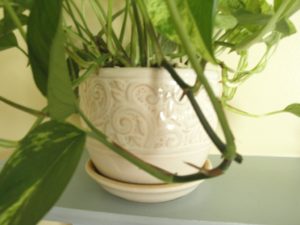 Pruning the stems short, 1 or 2 at a time, gives a more pleasing result than cutting stems 6″ or 10″ from the roots. When pruning pothos far from the soil, a new branch emerges from near the end of the stem, but it often grows at an awkward angle to the stem. In the photo above, I’m not cutting off much of this stem so I can add a photograph that will illustrate this detail.
Pruning the stems short, 1 or 2 at a time, gives a more pleasing result than cutting stems 6″ or 10″ from the roots. When pruning pothos far from the soil, a new branch emerges from near the end of the stem, but it often grows at an awkward angle to the stem. In the photo above, I’m not cutting off much of this stem so I can add a photograph that will illustrate this detail.
(***Update***: Photo, right, shows new growth with long internodes (spaces between the leaves) and an awkward turn of the stem. Now, I can cut back the entire stem. 6/2/2021)
Pinning Down Long Stems
A pot of pothos that does not have many stems can be thickened up by pinning down long stems. Take a long stem, with healthy leaves, and use wire or paper clips to hold them in contact with the soil.
Keep the surface damp and eventually the stem will take root in a few places. After they’ve rooted in, cut the stems in short sections and remove the clips. Those cut stems will send out new growing tips, creating a fuller plant. You could also add a few stems to the pot that you rooted in a glass of water, described below.
- Nephthytis, related to pothos, with stems pinned to the soil and new roots emerging.
- New growing tips on pothos after cutting rooted stems.
Propagating Pothos
If cutting off those long stems vexes you, perhaps you’d feel better if you rooted them. Pothos stems will grow roots in water and in soil.
In Water
Cuttings of vining aroids can live for years in water. I’ve kept a small vase with Philodendron panduraeforme (horsehead philodendron) for about 10 years. I keep it filled with water, of course, but also add dilute fertilizer a few times a year. Not a perfect specimen, my “little pony” has greatly reduced leaves. Soon, I’ll plant it in soil.
Pothos roots easily in water. But transplanting these cuttings to soil can be tricky. The roots that grow in water differ from those growing in soil. So, when the transition is made, the stems can struggle if they’re large (more than 2 or 3 leaves), in low humidity, and if the soil isn’t to their liking (too wet or dry).
If you intend to keep them in a vase of water, the cuttings can be reasonably long, with several leaves. Remove leaves and their petioles below water so they don’t foul it. Grow it in bright indirect light or filtered sun for a few hours. Add a small amount of diluted soluble fertilizer every 2 or 3 months.
Rooting Cuttings In Water For Potting Up Later
Cuttings that later will be planted in soil should be short. Cut the cuttings into pieces with 2 or 3 leaves each, about ¼” above a leaf node. Remove the bottom leaf. Cluster several short cuttings in a glass of water. Keep them in bright indirect light and at a comfortable temperature, around 70-75°F.
When roots have grown a few inches long, transplant the cuttings as a unit (roots will be entangled) into a 4″ pot filled with dampened potting soil. Firm the soil around and among the roots and water the pot. Give it very bright indirect light or filtered morning sun.
The plant might need a little assistance with humidity until it has adjusted. Place it into a taller clear plastic bag, but leave the top open. This surrounds the foliage with higher humidity while the plant adjusts. After a week or two, remove the bag.
In Soil
As a grower, I propagated pothos directly in soil. After preparing a few clean 4″ pots with potting soil (with extra peat moss), I cut the stems so only 1 leaf remained on each cutting. Each pot took around 6 cuttings. I removed old leaves or those not in good shape.
The stems were inserted into moist soil up to just below where the leaf’s petiole joined the stem. Roots grow along the stem, and they’re usually visible even before taking the cuttings. I often used an organic fungicide called Actinovate on cuttings that needed some protection from pathogens.
Flats of rooting plants needed to be covered with clear plastic to maintain high humidity. I placed them several inches below a shop light’s tubes. Kept warm, humid, and in bright light, new growth from the dormant buds sprouted a few weeks later.
If you root pothos cuttings in soil, after seeing new growth, lift the plastic gradually over a week or so, in order to prevent shocking the plant in the drier air. If the leaves wilt or curl, they might not be rooted well enough.
Fertilizing Pothos
Over time, plants exhaust the supply of nutrients in the soil. Without an adequate supply of all 16 or more elements (depending on species), they eventually will show symptoms of deficiency.
Plants have a greater demand for nitrogen than for other nutrients. A fertilizer label lists nitrogen first, followed by phosphorus (phosphate) and potassium (potash). “N-P-K” always appears on labels in that order. So, 5-1-1 and 24-8-16 have 5% and 24% N, respectively.
Nitrogen is crucial for formation of chlorophyll, and, therefore, for good green color and steady growth. Plants have complex life processes, and most nutrients perform many functions in plant cells. Generally, though, foliage plants need higher percentages of nitrogen than plants grown for flowers or fruits.
Regularly fertilizing gives plants all the nutrients they’ll need. With many of the commonly available fertilizers, applying a solution every 4 to 6 weeks, during the growing season, should be adequate. Plants hanging in there with less than ideal conditions should not be fertilized that often. Using 2 or 3 products in rotation ensures that one product that might be light in one of the nutrients will be compensated by another.
Cellular activities slow down during the shorter days of the year, so fertilize sparingly in winter, if at all. Plants kept in greenhouse conditions can be fertilized lightly in winter.
You can purchase fertilizers as concentrated liquids, soluble crystals, granular organics, and as controlled release prills. It is never a good idea to overfertilize plants. That does not make them grow twice as fast, but could kill them rather quickly.
Concluding
Now that you know what to do, find a good garden center or farmers’ market, and talk with the houseplant expert. Your local agricultural extension service and Master Gardeners are great sources of information for all gardening topics.
Pothos is one of the easiest plants to grow in your home and at work. And, as you can see from the 2 examples mentioned in this article, they can live for many years, even in small pots. Happy gardening (because there’s no other kind).
Headings
Page 1: Of Pothos and Pandemics (The Joys of Gardening, Psychological Well-Being, A School Experiment), Getting Back To Work, Family Traits, and Caring For Pothos Indoors (Leaves Turn Toward the Light, When Leaves Turn All Green, Loss of Variegation)
Page 2: Watering Pothos (“How can I tell when pothos needs water?”, Let It Wilt, Feel the Weight, When Water Can’t Drain, Water Temperature, Guttation), Potting Up (Why the Soil Surface Drops Lower, Insects and Spider Mites, Time For a Bigger Pot, When To Repot, The Process: How To Repot Pothos), Pruning Pothos (Prune the Stems Short, Pinning Down Long Stems), Propagating Pothos (In Water, In Soil), and Fertilizing Pothos
